Agricultural and Biological Research
RNI # 24/103/2012-R1
Research Article - (2023) Volume 39, Issue 4
The study's overarching goal is to examine the effects of three different types of organic fertilizer on the growth of Amaranthus dubius vegetative parts. On a split plot, we applied five different amendments: None (M1), cow dung (M2), chicken dung (M3), goat dung (M4), and an equal quantity of cow dung, chicken dung, and goat dung (M5), all at 2 kg N/ha. Experiments showed that Nitrogen (N), Potash (K2O), Organic Carbon (C), and Phosphorus (P), as well as stem and leaf length and breadth and number of leaves, were all substantially (P<0.01) enhanced after applications of these organic manures. The measurements taken included the height of the plant (10.1 cm to 43.2 cm), the breadth of the stem (2.1 cm to 5.9 cm), and the length of the leaves (6.2 cm to 12.1 cm), the width of the leaves (2.7 to 8.9 cm), and the number of leaves per plant (5 to 12). Plants grown with goat manure (M4) were shown to have greater mean values for N, K2O, C, and P, stem length, stem width, leaf length, leaf width, and the number of leaves per plant compared to values obtained from treatments with other organic manures. Across the board, goat dung outperformed dairy cow manure and chicken manure in the evaluations. This factored into the variation in the amendments' total nitrogen, potassium, phosphorus, and carbon content. The greatest responses in the field experiments occurred after the third crop harvest, which is consistent with an increase in organic N and P mineralization over time.
Agriculture; Amaranthus dubius; Fertilizer; Nitrogen; Potassium; Phosphorus
Amaranthus has 70 species in 3 subgenera. Self-pollinated, it has male and female blooms. Raw or slightly cooked leaves and stems are nutritious. Animals and humans eat Amaranthus. Calcium, iron, phosphorus, and carotenoids are abundant. Lysine and sulfur containing amino acids are abundant in Amaranthus grains. Fat rich Amaranthus contains 6%-10% oil and 77% polyunsaturated fatty acid. Linoleic acid is necessary. Deficits in this lipid cause several health problems. Future crops include Amaranthus. Amaranthus grain and leaves are global orphan crops. Farmers like Amaranthus for its qualities, growth rate, and C4 photosynthesis, usage of grain and leaves, and environmental stress tolerance. Seeds contain beneficial chemicals that reduce chronic illness risk. Short branches and scattered branches distinguish Amaranthus dubius. It grows quickly and produces many seeds. Seedlings sprout 2-3 days after seeding. It was edible after 10-13 days. In Tamil Nadu, stems and leaves are boiled for 4-5 minutes and eaten with rice. It was beneficial for farmers, particularly small scale and rural farmers. Because it grows quickly, requires little investment, and is marketable. It's rich in vitamins, notably A. It prevents and preserves eye health. The leaves have 3 times more vitamin C than spinach, 18 times more vitamin A, 20 times more calcium, and 7 times more iron than lettuce. Other Amaranthus seeds are larger. It is less drought resistant than a cruentus. Organic manures are cheap and sustainable. They replace expensive inorganic fertilizers. Plants absorb inorganic fertilizers animal waste is a big pollutant. Recycling animal waste improves soil texture, productivity, and the environment. In Asia, organic manure is one of the essential sectors for agricultural conservation and has played a vital part in plant nutrition. Asia is one of the primary nations that generate ~51% of plant accessible nutrients of the world's total rate from industry, notably chicken industries. But the application of inorganic fertilizer continually will lead to loss of soil fertility. Soil productivity depends on soil condition, fertilizer type, organic matter, and plant kind. Organic manure is a zero cost (or) low cost additive. The excrement of plants and animals was left to decompose for weeks to months. High nutrition manure was generated.
Manure contains microbiota from plant and animal waste. It helps farmers maximize productivity and preserve nutritional levels. Because they cannot afford chemical fertilizers, impoverished nations prescribed organic manure. Organic manure is made from agricultural, poultry, food, rice, sugar, and cotton industry wastes. Farmers prefer direct nutrient inorganic fertilizers. Plants quickly absorbed nutrients. However, excessive chemical fertilizer usage caused environmental issues. Some fertilizers include heavy metals and large quantities of radionuclides. Cow dung is excreta of poultry animals, and it is a low cost bio resource. It has a broad variety of microbiota and many of them are advantageous to both humans and crops. Many bacteria can enrich the soil. The cow dung microbiome includes Enterobacter aerogenes, E. coli, Citrobactor koseri, Klebsiella oxytoca, Klebsiella pneumoniae, Kluyvera spp., Pasteurella spp., Providencia alcaligenes, Pseudomonas spp., Providencia stuartii, Morgarella morganii, and others [1].
Goat manure is abundant. It's often applied a week before planting. It may maximize plant nutrient uptake after crushed goat dropping pellets. Crop growth rose. Stress resistant and product quality measurable. Goat dung increased sodium, calcium, magnesium, potassium, and phosphorous in soil. Small scale farmers and rural residents benefited. Chicken excrement, rich in N, P, and K, was a key plant nutrition source. Manure has 30%–50% nitrogen and was widely accessible [2]. Micronutrients condition the soil. Chicken droppings are tiny and biodegradable. Unlike cow and goat excrement, it directly feeds plants. It's a potent nutritional source, so utilize it properly. This component maximizes nutrient usage and agro economic status. Due to its high micronutrient content, chicken manure is popular. It boosts soil water soluble salts. High chicken manure will impact seed germination and root development. It's an excellent soil amendment when utilized properly. It increases soil and foliage nutrients, notably N, P, K, Ca, and Mg. Ammonia from chicken dung increases land nitrogen levels. Seed germination will suffer metabolic issues. To reduce the nutritional value, manure must be watered. It will help dilute chicken manure's vitality. Thus, the reaction of red amaranth to manures (cow dung, chicken manure, and oil cake) in the presence of N, P, and K and its influence on soil quality in the old Brahmaputra flood plans, Bangladesh, was studied [3].
Experimental site
The research was carried out on my own agricultural land, which is located on kasanadu pudhur. Kasanadu pudhur is one of the rice producing villages in Thanjavur (Figure 1). The research is carried out in isolated land which is free from cultivation and chemical fertilization. The area receives annual rainfall between 775-792 mm and experiences mean annual temperature range of 27.6°C-28.8°C. Day length ranges from 12.4 hours in summer to 11.3 hours in winter. The soils have a PH range of 8.2-8.5 [4].
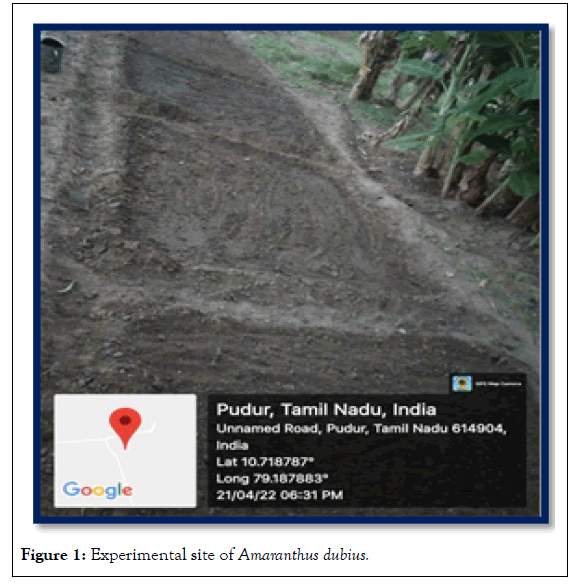
Figure 1: Experimental site of Amaranthus dubius.
Soil analysis
Soil physico chemical analysis of the experimental site and manure was carried out prior to land preparation.
Collection of seed and fertilizer
The Amaranthus dubius seeds were purchased from Seyon biotech research center, Thanjavur. Cow dung and chicken manure were brought from my own farm house. Goat dung was purchased from small scale farmers near my village. The manures were collected, cleaned and thoroughly crushed before use [5].
Measurement of manure
Every manure is weighed on 2 kg. There are 4 types of manure has been used.
M1 zero (control), M2 cow dung 2 kg, M3 chicken manure 2 kg, M4 goat dung 2 kg, M5 equal amount of cow dung, chicken manure and goat dung 2 kg (Figure 2).
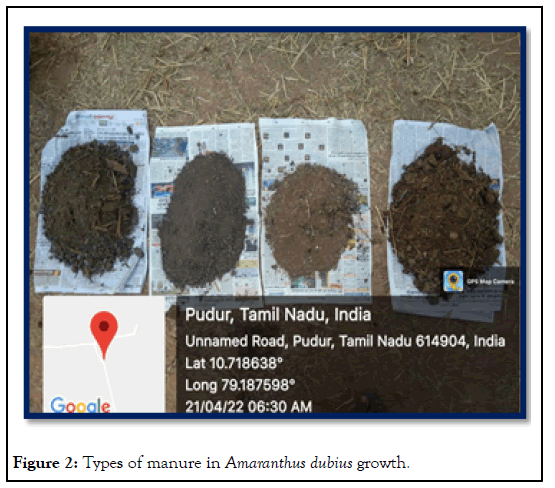
Figure 2: Types of manure in Amaranthus dubius growth.
Preparation of bed
Following the clearance of the field, the soil was tilled using hoe. The land was stirred thoroughly and leveled to equally. Measuring tape was used to measure a plot 35 by 35 meter square. The plot was further divided into 6.5 meter length and 5.5 meter width. The distance between plots is 0.3 to 0.5 m. The four treatments were identified as M1, M2, M3, M4, and M5 for zero fertilizer, cow dung, chicken manure, goat dung, and equal amount of all manure respectively [6].
Sowing the seeds and application of fertilizer
The seeds were weighed 130 g per pith and mixed with sand. The seeds dusting equally. Make sure that the seeds move to 1-2 cm deep down. After this process the fertilizers were equally distributed and allowed it to mix with soil [7].
Watering and weeding
After sowing the seeds, the beds were watered twice, morning and evening. The volume of water used for each plot was 20-22 liters. Amaranthus neither require too much moisture nor dryness. Water shortage will leads to early flowering and reduce the yield. Too much of water washes the seed away from the plots due to their lightness and high dryness also make the plants to sprout and wilt, thereby causing them to become yellow in color and finally die off. The seeds have variability in germination. So, some seeds started germinating on the second day after planting while others on the third and fourth days. The weeding was done whenever the need arises using hands for the weeds on the weeds on the beds [8].
Data analysis
Plant parameters were recorded on 10 randomly selected plants on weekly basis. Plant height was recorded using a flexible tape measure. Numbers of leaves were physically counted and stem growth was measured using a Vernier caliber at the plant crown. Fresh yield was measured using a digital scale [9].
Analysis of nutritional value
Estimation of chlorophyll, moisture content, ash content, crude fiber content, protein, carbohydrate and lipid.
In this study, four different treatments were used. You may use no fertilizer at all, cow manure, chicken manure, goat manure, or a combination of all five manures labeled M1, M2, M3, M4, and M5. Stem height, stem diameter, leaf area, and the total number of leaves are all evaluated. Data was gathered daily and weekly means were computed (Figure 3) [10].
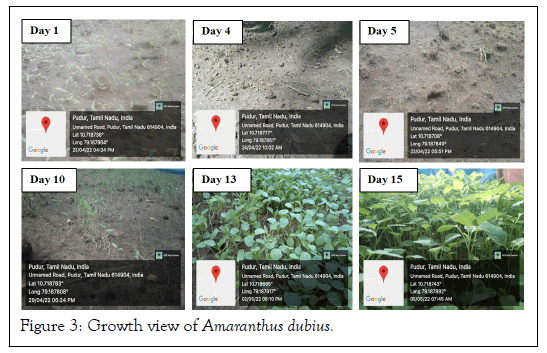
Figure 3: Growth view of Amaranthus dubius.
Chemical properties of the soil
There are 2 types of soil test held on the experimental site, before and after the experiment was done. The Table 1 indicates the result of chemical properties of soil before plantation. The PH of the soil is 8.3, and the nitrogen 62.8 kg/Ac, phosphorous 4.15 kg/Ac, and potash level is 190 kg/Ac. The Table 2 indicates the result of chemical properties of soil after cultivation of Amaranthus dubius. The goat dung increase the nitrogen and potash level, but decrease the phosphorous level. All the manure decreases the phosphorous level. Phosphorous usually soft base in nature, so it proved that all the manure contain some amount of acid in their composition Table 2 [11].
| Chemical properties | Compositions |
|---|---|
| Soil color | Grey |
| Calcareousness (CaCO3) | Nil |
| Soil reaction PH | 8.3 |
| Soil salinity (dSm-1) | 0.2 |
| Organic carbon (%) | 0.47 |
| Nitrogen (N) | 62.8 kg/Ac |
| Phosphorous (P2O5 ) | 4.15 kg/Ac |
| Potash (K2O) | 190 kg/Ac |
TABLE 1: Chemical properties of the soil before the experiment .
| Chemical properties | M1 | M2 | M3 | M4 | M5 |
|---|---|---|---|---|---|
| Soil color | Grey | Grey | Grey | Grey | Grey |
| Calcareousness (CaCO3) | Nil | Nil | Nil | Nil | Nil |
| Soil reaction PH | 8.2 | 8.2 | 8.3 | 8.4 | 7.6 |
| Soil salinity (dSm-1) | 0.18 | 0.14 | 0.09 | 0.11 | 0.1 |
| Organic carbon (%) | 0.45 | 0.55 | 0.58 | 0.63 | 0.52 |
| Nitrogen (N) | 62.8 kg/Ac | 62.2 kg/Ac | 69.2 kg/Ac | 72.4 kg/Ac | 66 kg/Ac |
| Phosphorous ( P2O5 ) | 7.15 kg/Ac | 5.15 kg/Ac | 4.15 kg/Ac | 5.15 kg/Ac | 4.15 kg/Ac |
| Potash ( K2O) | 130 kg/Ac | 170 kg/Ac | 290 kg/Ac | 315 kg/Ac | 145 kg/Ac |
TABLE 2: Chemical composition of the soil after experiment
Measurement of the stem length
Table 3 shows the results obtained from the measurement of the stem length. The table indicates goat manure treatment is having the longest stem throughout the weeks with a maximum length of 43.2 cm at the fifth week. Zero fertilizer, cow dung, chicken droppings, mixer of all manure and having a maximum length of 10.3 cm, 13.5 cm, 19.9 cm and 29.4 cm respectively (Figure 4).
| Weeks | M1 | M2 | M3 | M4 | M5 |
|---|---|---|---|---|---|
| First | 3.8 cm | 3.5 cm | 3.3 cm | 4.2 cm | 3.6 cm |
| Second | 7.2 cm | 6.9 cm | 9.5 cm | 14.4 cm | 13.5 cm |
| Third | 8.3 cm | 7.9 cm | 11.2 cm | 20.3 cm | 21.3 cm |
| Fourth | 10.3 cm | 13.5 cm | 19.9 cm | 43.2 cm | 29.4 cm |
Note: (M1: Zero fertilizer; M2: Cow dung; M3: Chicken manure; M4 : Goat manure; M5: Mixture of all manure)
TABLE 3: Measurement of stem length
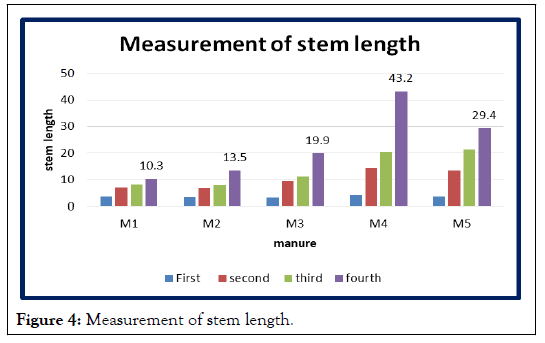
Figure 4: Measurement of stem length.
Measurement of the stem width
The results obtained from the measurement of the measurement of the stem width are shown in Table 4. Plants treated with goat manure found to have a thickest stem with the maximum width of 5.9 cm at the fourth week. It was followed by others those are treated with zero fertilizer 2.1 cm, cow dung 2.4 cm, chicken droppings 3.2 cm and mixture of all manures 4.3 cm (Figure 5) [12].
| Weeks | M1 | M2 | M3 | M4 | M5 |
|---|---|---|---|---|---|
| First | 0.3 cm | 0.4 cm | 0.9 cm | 1.8 cm | 1.5 cm |
| Second | 0.9 cm | 1.3 cm | 1.4 cm | 2.5 cm | 2.2 cm |
| Third | 1.5 cm | 2.1 cm | 2.7 cm | 3.7 cm | 2.9 cm |
| Fourth | 2.1 cm | 2.4 cm | 3.2 cm | 5.9 cm | 4.3 cm |
TABLE 4: Measurement of stem width
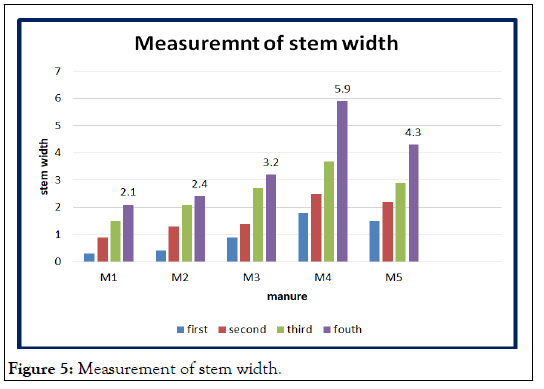
Figure 5: Measurement of stem width.
Measurement of the leaf length
Table 5 shows measurement of leaf length. Goat manure treatment has a highest leaf length measurement of 12. 1 cm and the measurement obtain from other manures are zero fertilizer, cow dung, chicken manure and goat dungs with leaf length of 6.2 cm, 5.5 cm, 6.4 cm and 8.5 cm respectively [13].
| Weeks | M1 | M2 | M3 | M4 | M5 |
|---|---|---|---|---|---|
| First | 0.4 cm | 0.4 cm | 0.7 cm | 5.5 cm | 4.2 cm |
| Second | 2.8 cm | 3.1 cm | 3.4 cm | 7.2 cm | 5.4 cm |
| Third | 4.9 cm | 3.8 cm | 5.2 cm | 9.6 cm | 6.5 cm |
| Fourth | 6.2 cm | 5.5 cm | 6.4 cm | 12.1 cm | 8.5 cm |
TABLE 5: Measurement of leaf length
Measurement of the leaf width
The results obtain from the measurement of leaf width was shown in Table 6. A goat dung treatment produce long leaf throughout the week and maximum rate of leaf width is 8.9 cm. The result collected from other manures are zero fertilizer, cow dung, chicken manure and mixer of all manure are 2.7 cm, 3.1 cm, 4.4 cm and 5.4 cm [14].
| Weeks | M1 | M2 | M3 | M4 | M5 |
|---|---|---|---|---|---|
| First | 0.5 cm | 0.7 cm | 1.0 cm | 2.3 cm | 1.5 cm |
| Second | 1.1 cm | 1.4 cm | 2.4 cm | 4.3 cm | 3.6 cm |
| Third | 1.9 cm | 2.5 cm | 3.9 cm | 6.8 cm | 4.8 cm |
| Fourth | 2.7 cm | 3.1 cm | 4.4 cm | 8.9 cm | 5.4 cm |
TABLE 6: Measurement of leaf width
Measurement of leaves per plant
The results obtained for the number of leaves per plant are shown in Table 7. Based on the observed data, goat manure treatment produce the maximum number of leaves with 12 leaves, it was followed by the zero fertilizer, cow dung, chicken manure and mixer of all manure which provides 5, 6, 8, 9 leaves at the fourth week of the experiment [15].
| Weeks | M1 | M2 | M3 | M4 | M5 |
|---|---|---|---|---|---|
| First | 3 | 3 | 3 | 3 | 3 |
| Second | 3 | 5 | 5 | 7 | 5 |
| Third | 5 | 5 | 7 | 8 | 7 |
| Fourth | 5 | 6 | 8 | 12 | 9 |
TABLE 7: Measurement of leaves per plant
Nutritional value
Chlorophyll content of Amaranthus dubius is obtained and the treatment with goat manure leaves contain high amount of chlorophyll content than other type of manures. The moisture content and ash content also high in goat manure treated Amaranthus dubius. The nutritional values of fiber, carbohydrate, protein and fat found maximum amount in Amaranthus dubius which treat with goat manure and mixture of all manure and chicken droppings treated plants have nearly same amount of nutrition values. But zero fertilizer and cow dung treated plants contain nearly same amount of nutrition. Therefore that’s indicates application of cow dung cannot improved the plant growth and nutritional value like other manures (Table 8 and Figure 6) [16].
| Weeks | M | M2 | M3 | M4 | M5 |
|---|---|---|---|---|---|
| Chlorophyll (%) | 29.8 | 27.8 | 27.6 | 30.5 | 26.8 |
| Moisture content (%) | 18.8 | 21.6 | 23.6 | 35.8 | 25.4 |
| Ash content (%) | 12.2 | 19.9 | 19.6 | 24.4 | 20.4 |
| Crude fiber | 5.1 | 4.9 | 5.4 | 6.6 | 5.8 |
| CHO | 47.3 | 47.4 | 51.5 | 52.3 | 53.1 |
| Protein | 9.7 | 9.9 | 10.3 | 11.2 | 9.5 |
| Fat | 0.91 | 0.72 | 0.74 | 0.93 | 0.77 |
TABLE 8: Chlorophyll content of Amaranthus dubius .
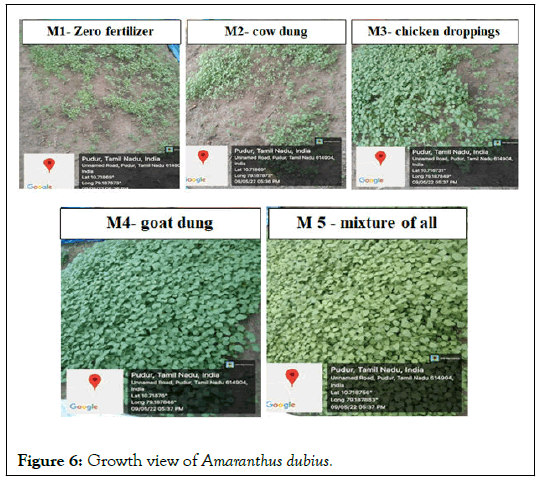
Figure 6: Growth view of Amaranthus dubius.
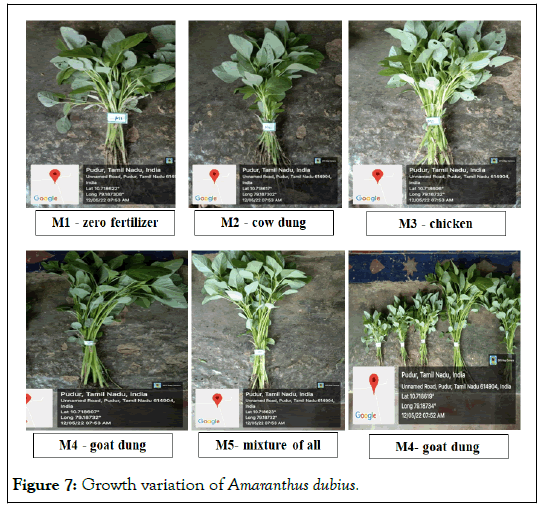
Figure 7: Growth variation of Amaranthus dubius.
Result of the experiment indicates the application of the animal manure and it significantly increases the chemical properties of the soil. The soil is containing minimum nutrients of nitrogen (62.8 kg/Ac), phosphorous (4.15 kg/Ac), and potash (190 kg/Ac). After the treatment of animal manure soil available levels of nitrogen, phosphorous and potash level increased respectively [17]. Thus it indicates, the application of organic manure have a capacity to increase the nutritional level of soil which are the essential nutrients for plants. Goat manure increase the maximum level of soil properties, nitrogen (72.4 kg/Ac), phosphorous (5.15 kg/Ac), potash (315 kg/Ac) [18]. The results revealed the variations of different organic manure and was goat manure (M4)>chicken manure (M3)>cow dung (M2)>mixture of all manure (M5)>zero fertilizer (M1) (M1). The interesting results from this experiment are application of organic manure decrease the salinity and phosphorous level. Chicken manure has a maximum capacity to decrease the salinity level. (0.09), when compared to zero fertilizer (0.18) (0.18). Chicken manure and mixer of all manure have a capacity to lowering of phosphorous level 4.15 kg/Ac, 4.15 kg/Ac, than compared to zero fertilizer 7.15 kg/Ac respectively. Application of all manure (M5) reduced the PH of 7.6, when compared to zero fertilizer (8.2). Chicken manure and goat dung increase the PH 8.3 and 8.4. In the result of nutritional value of the Amaranthus dubius proved that goat manure have capacity to improve the soil texture, plant growth and nutritional value of Amaranthus dubius than other manures or absence of manure. Goat manure managed in the same way as cattle manure was found to be of better quality when applied to the field than cattle manure for macronutrients. N, P, K [19]. Goat manure was largely utilized in vegetables crops, since farmers felt that it is superior to cattle dung. Goat dung used in vegetable gardens is consequently exposed to the weather factors, such gaseous losses and leaching by rain for a shorter period than bovine manure. From the experiment, goat manure has the highest increase for carbon and nitrogen content as observed from the soil treated with goat dung (M4) to show higher plant height, leaf length, leaf width, stem width and number of leaves compared to zero fertilizers (M1), cow dung (M2), chicken droppings (M3), and mixture of all manure (M5). Result of the experiment reveals the application of the animal dung and it greatly enhances the chemical qualities of the soil. The soil contains include minimal nutrients of nitrogen (62.8 kg/Ac), phosphorous (4.15 kg/Ac), Potash (190 kg/Ac). After the treatment of animal manure soil accessible levels of nitrogen, phosphorous and potash level rose accordingly [20]. Thus it reveals, the application of organic manure have a power to raise the nutritional content of soil which are the vital nutrients for plants. Goat manure enhance the maximum level of soil characteristics, nitrogen (72.4 kg/Ac), phosphorus (5.15 kg/Ac), Potash (315 kg/Ac). The findings demonstrated the variations of various organic manure and was goat manure (M4)>chicken manure (M3)>cow dung (M2)>combination of all manure (M5)>zero fertilizer (M1) (M1). The notable outcomes from this experiment include application of organic manure lower the salinity and phosphorus level. Chicken faces have a greatest potential to lower the salt level. (0.09), as compared to zero fertilizer (0.18). Chicken manure and mixer of all manure have a capability to decreasing of phosphorus level 4.15 kg/Ac, 4.15 kg/Ac, than compared to zero fertilizer 7.15 kg/Ac correspondingly. Application of entire manure (M5) lowered the PH of 7.6, when compared to zero fertilizer (8.2). Chicken manure and goat dung raise the PH 8.3 and 8.4. In the outcome of nutritional value of the Amaranthus dubius shown that goat dung have power to increase the soil texture, plant development and nutritional value of Amaranthus dubius than other manures or lack of manure.
Goat dung treated in the same manner as cattle manure was found to be of greater quality when put to the field than cow manure for macronutrients N, P, K. Farmers utilized goat dung more often than cattle manure in their food plants. For this reason, goat manure is preferable to cattle manure for use in vegetable gardens because it is less likely to suffer detrimental effects from prolonged exposure to gaseous losses and leaching by rain. Soil treated with goat dung (M4) increased in carbon and nitrogen content, and plants grew taller, wider, and had more leaves than those grown in soil with no fertilizer, according to the experiment.
The authors sincerely express their gratitude for providing research fund and other facilities to the Bangladesh Institute of Nuclear Agriculture (BINA).
There is no conflict of interest among the authors about this research.
[Crossref] [Google Scholar] [PubMed]
[Crossref]
[Crossref] [Google Scholar] [PubMed]
[Crossref] [Google Scholar] [PubMed]
[Crossref] [Google Scholar] [PubMed]
Citation: Ramadevi S, Sivaranjani S, Vijaya Samoondeeswari S, et al. Comparative study of organic manure (cow dung, goat dung and chicken manuare) on the vegetative growth of Amaranthus dubius L. AGBR.2023;39(4):1-7.
Received: 14-Feb-2023, Manuscript No. AGBIR-23-89353; , Pre QC No. AGBIR-23-89353 (PQ); Editor assigned: 16-Feb-2023, Pre QC No. AGBIR-23-89353 (PQ); Reviewed: 02-Mar-2023, QC No. AGBIR-23-89353; Revised: 21-Apr-2023, Manuscript No. AGBIR-23-89353 (R); Published: 28-Apr-2023, DOI: 10.35248/0970-1907.23.39.(4).1-7
